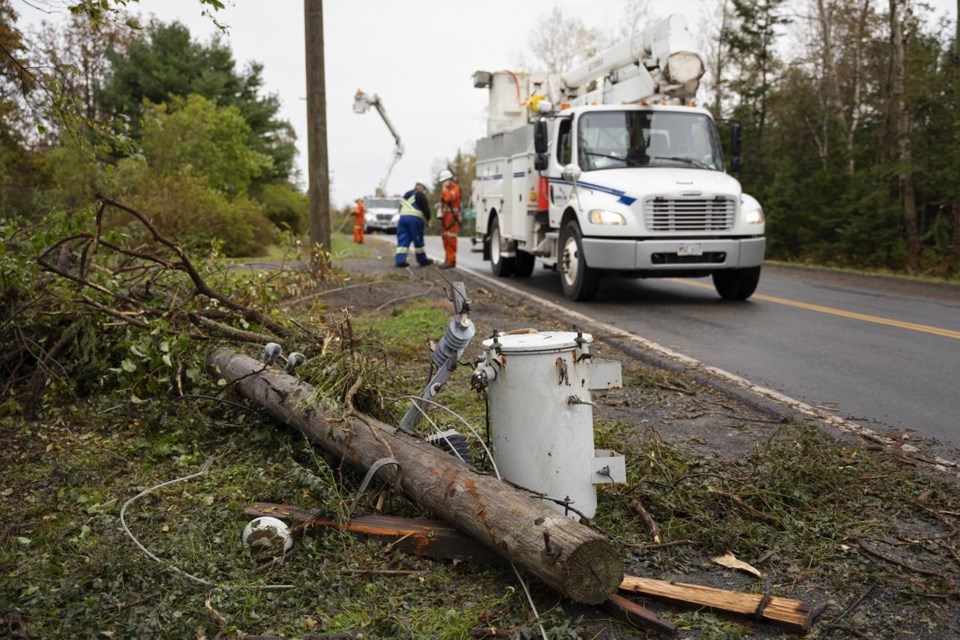HALIFAX — Vaughn Mullen has grown weary of Nova Scotia Power's promises for improvement, as fall hurricane season brings lengthy power outages he feels could be avoided.
The 73-year-old says he's come to expect that the lights in his rural home will go out in major storms, despite the push for change after post-tropical storm Fiona swept through Nova Scotia a year ago causing $114.5 million in damage to the province's electricity system.
"Whether it's tree trimming or pole maintenance or whatever it may be that Nova Scotia Power is supposed to be doing, it doesn't seem to be working," Mullen said Monday from Brooklyn, N.S., two days after he again lost power during post-tropical storm Lee.
When Fiona struck early on Sept. 24, it took down 3,073 electricity wires, broke 2,700 poles and damaged 44 transmission lines in Nova Scotia, drawing calls for the utility to strengthen its grid.
Earlier this year, the company was fined $750,000 for failing to meet performance standards on system reliability in 2022, and it faces a regulatory hearing on how much of the cost from Fiona damage it can pass along to ratepayers.
"I think (Nova Scotia Power) needs to speed up its response," Darlene Norman, mayor of the Region of Queens Municipality, said in a recent interview from Liverpool, N.S.
She says the utility should work more quickly on protecting power lines on lands where is has the right to cut trees. But residents also need to accept that "some of those beautiful old trees" that threaten lines on private land will have to come down.
The utility held a news conference in August to highlight its progress since Fiona, noting that its tree-cutting budget will have doubled to $45 million by next year. "We're also installing larger and stronger poles that can withstand the trees coming down better and insulators that are more resilient to high winds," Matt Drover, director of energy delivery, said in an interview Tuesday.
According to Nova Scotia Utility and Review Board, the performance standard in extreme events is to have power restored to 78 per cent of customers within two days. Drover said on Monday that 98 per cent of customers had their power back within two days of Lee.
But for some small businesses, the long-term answer lies in more ambitious initiatives, such as burying power lines in new subdivisions.
Tammy Flynn, owner of Coconut Creek Gift Shop in the Dartmouth Crossing shopping area where power lines are underground, said in an interview on Tuesday her shop's lights stayed on throughout both Fiona and Lee.
"With the system underground, I don't have to worry about my equipment ... and I don't have to worry about closing my store for long periods of time," she said.
Larry Hughes, a professor of electrical and computer engineering at Dalhousie, said there are issues with line burial, including costs that can be 10 times more than overhead lines.
"Cables must be laid in conduits to protect against water; shorts can be hard to isolate, although smart distribution transformers can help," he said in an email. And even if the local distribution system is protected, he added, that doesn't help if the larger transmission grid goes down.
He suggested that the "middle way" of first spending heavily on tree trimming, better poles and more resilient transformers may be an interim solution.
Shawn Cleary, a Halifax city councillor whose district includes some buried lines, said municipal governments currently have no legal authority to force utilities to pay for burying power lines.
In new subdivisions, he said, there may be ways to change land-use bylaws so developers have to bury lines. But "there would be pushback" from developers, he added, and it could add to home prices at a time of a housing crisis.
Still, a year after Fiona, the pressure on the utility and governments to improve power grid reliability is growing.
As of April, provincial legislation allows for fines of up to $25 million annually if Nova Scotia Power fails to meet performance standards, rather than the prior limit of $1 million.
In addition, the utility board will rule at some point next year on how the costs Nova Scotia Power incurred during Fiona will be split between ratepayers and the utility, as it determines "if the costs were reasonable and prudently incurred."
Nelson Blackburn, a lawyer who represents small-business ratepayers, said in an email he's unsure if "there is a clear, one-size-fits-all solution ... but what is clear is that the status quo is not sufficient."
"The grid must be improved to face the climate change that we are in the midst of, keeping in mind the concern of affordability and the need to transition towards a carbon-zero future."
At his home on Nova Scotia's South Shore, Mullen isn't counting on the utility to make major strides. "People like me have accepted the inevitable and purchased generators to deal with this," he said.
This report by The Canadian Press was first published Sept. 22, 2023.
Michael Tutton, The Canadian Press



